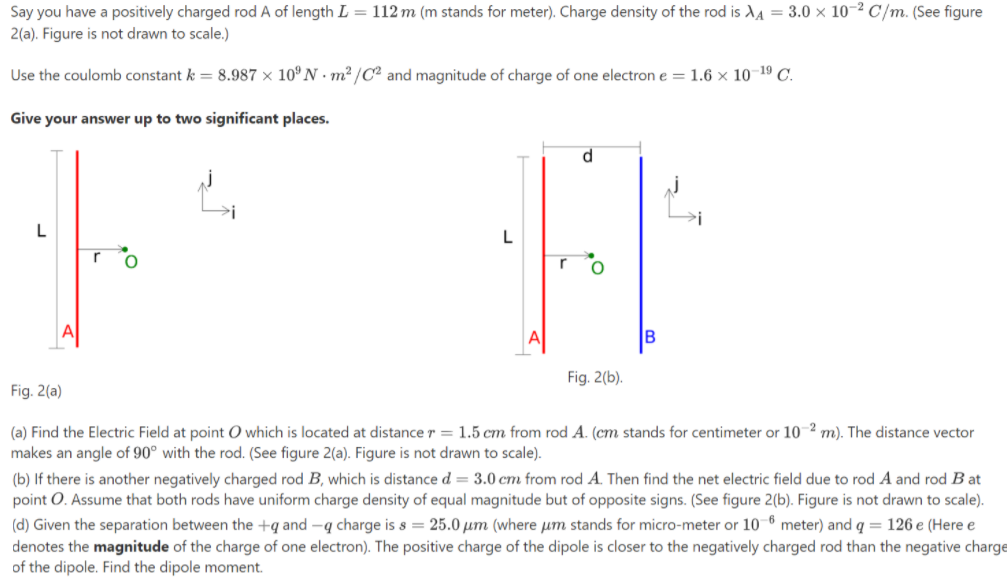Say you have a positively charged rod A of length L = 112 m (m stands for meter). Charge density of the rod is XA = 3.0 × 10-² C/m. (See figure 2(a). Figure is not drawn to scale.) Use the coulomb constant k = 8.987 × 10º N · m2 /C² and magnitude of charge of one electron e= 1.6 × 10-19 C. Give your answer up to two significant places. d. L A B Fig. 2(b). Fig. 2(a) (a) Find the Electric Field at point O which is located at distancer= 1.5 cm from rod A. (cm stands for centimeter or 10 2 m). The distance vector makes an angle of 90° with the rod. (See figure 2(a). Figure is not drawn to scale). (b) If there is another negatively charged rod B, which is distance d = 3.0 cm from rod A. Then find the net electric field due to rod A and rod B at point O. Assume that both rods have uniform charge density of equal magnitude but of opposite signs. (See figure 2(b). Figure is not drawn to scale). (d) Given the separation between the +q and -q charge is s = 25.0 µm (where um stands for micro-meter or 10 6 meter) and q = 126 e (Here e denotes the magnitude of the charge of one electron). The positive charge of the dipole is closer to the negatively charged rod than the negative charge of the dipole. Find the dipole moment.
Say you have a positively charged rod A of length L = 112 m (m stands for meter). Charge density of the rod is XA = 3.0 × 10-² C/m. (See figure 2(a). Figure is not drawn to scale.) Use the coulomb constant k = 8.987 × 10º N · m2 /C² and magnitude of charge of one electron e= 1.6 × 10-19 C. Give your answer up to two significant places. d. L A B Fig. 2(b). Fig. 2(a) (a) Find the Electric Field at point O which is located at distancer= 1.5 cm from rod A. (cm stands for centimeter or 10 2 m). The distance vector makes an angle of 90° with the rod. (See figure 2(a). Figure is not drawn to scale). (b) If there is another negatively charged rod B, which is distance d = 3.0 cm from rod A. Then find the net electric field due to rod A and rod B at point O. Assume that both rods have uniform charge density of equal magnitude but of opposite signs. (See figure 2(b). Figure is not drawn to scale). (d) Given the separation between the +q and -q charge is s = 25.0 µm (where um stands for micro-meter or 10 6 meter) and q = 126 e (Here e denotes the magnitude of the charge of one electron). The positive charge of the dipole is closer to the negatively charged rod than the negative charge of the dipole. Find the dipole moment.
Physics for Scientists and Engineers with Modern Physics
10th Edition
ISBN:9781337553292
Author:Raymond A. Serway, John W. Jewett
Publisher:Raymond A. Serway, John W. Jewett
Chapter23: Continuous Charge Distributions And Gauss's Law
Section: Chapter Questions
Problem 38AP
Related questions
Question

Transcribed Image Text:Say you have a positively charged rod A of length L = 112 m (m stands for meter). Charge density of the rod is XA = 3.0 × 10-² C/m. (See figure
2(a). Figure is not drawn to scale.)
Use the coulomb constant k = 8.987 × 10º N · m2 /C² and magnitude of charge of one electron e= 1.6 × 10-19 C.
Give your answer up to two significant places.
d.
L
A
B
Fig. 2(b).
Fig. 2(a)
(a) Find the Electric Field at point O which is located at distancer= 1.5 cm from rod A. (cm stands for centimeter or 10 2 m). The distance vector
makes an angle of 90° with the rod. (See figure 2(a). Figure is not drawn to scale).
(b) If there is another negatively charged rod B, which is distance d = 3.0 cm from rod A. Then find the net electric field due to rod A and rod B at
point O. Assume that both rods have uniform charge density of equal magnitude but of opposite signs. (See figure 2(b). Figure is not drawn to scale).
(d) Given the separation between the +q and -q charge is s = 25.0 µm (where um stands for micro-meter or 10 6 meter) and q = 126 e (Here e
denotes the magnitude of the charge of one electron). The positive charge of the dipole is closer to the negatively charged rod than the negative charge
of the dipole. Find the dipole moment.
Expert Solution
This question has been solved!
Explore an expertly crafted, step-by-step solution for a thorough understanding of key concepts.
This is a popular solution!
Trending now
This is a popular solution!
Step by step
Solved in 3 steps

Recommended textbooks for you

Physics for Scientists and Engineers with Modern …
Physics
ISBN:
9781337553292
Author:
Raymond A. Serway, John W. Jewett
Publisher:
Cengage Learning

Principles of Physics: A Calculus-Based Text
Physics
ISBN:
9781133104261
Author:
Raymond A. Serway, John W. Jewett
Publisher:
Cengage Learning

Physics for Scientists and Engineers, Technology …
Physics
ISBN:
9781305116399
Author:
Raymond A. Serway, John W. Jewett
Publisher:
Cengage Learning

Physics for Scientists and Engineers with Modern …
Physics
ISBN:
9781337553292
Author:
Raymond A. Serway, John W. Jewett
Publisher:
Cengage Learning

Principles of Physics: A Calculus-Based Text
Physics
ISBN:
9781133104261
Author:
Raymond A. Serway, John W. Jewett
Publisher:
Cengage Learning

Physics for Scientists and Engineers, Technology …
Physics
ISBN:
9781305116399
Author:
Raymond A. Serway, John W. Jewett
Publisher:
Cengage Learning

Physics for Scientists and Engineers: Foundations…
Physics
ISBN:
9781133939146
Author:
Katz, Debora M.
Publisher:
Cengage Learning

College Physics
Physics
ISBN:
9781305952300
Author:
Raymond A. Serway, Chris Vuille
Publisher:
Cengage Learning

College Physics
Physics
ISBN:
9781285737027
Author:
Raymond A. Serway, Chris Vuille
Publisher:
Cengage Learning